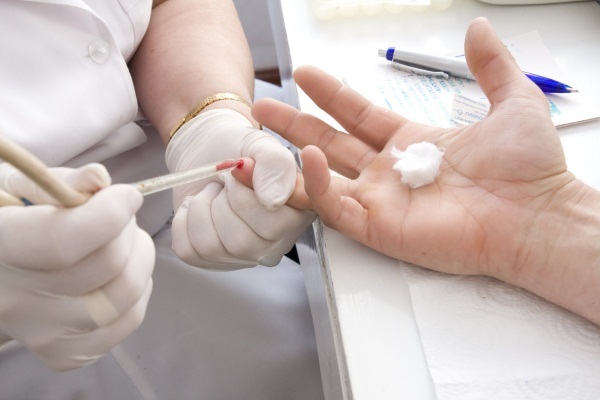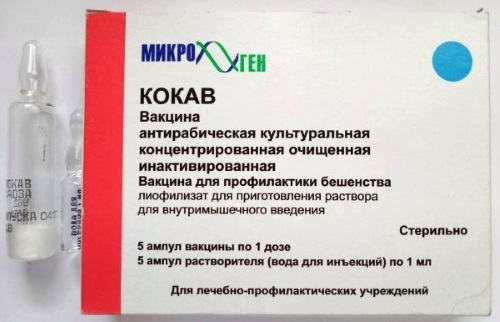Rabies shot Is a therapeutic or prophylactic procedure that can be prescribed to a person who has had contact with wild or domestic animals with signs of this disease.
Injection preparations are intended for intramuscular injection into the soft tissues of the shoulder or buttocks, and their active component is an inactivated rabies virus, which has undergone preliminary cleaning. These are anti-rabies vaccines that allow a quick and effective immunization of a person who has been attacked by animals with rabies.
High-quality rabies vaccines are safe for human health, and pathogenic microorganisms, contained in their composition, are not able to aggravate the course of the disease, or else cause the occurrence disease. The table below details the main types of rabies shots that are used to treat and prevent disease.
| Types of rabies shots | Purpose of the medicinal product |
| Rabies immunoglobulin | This is a common name for all injectable drugs that can achieve the effect of rapid immunization. Rabies immunoglobulin is a protein fraction of the horse's blood serum, which has an immune status. As a stabilizer of the biochemical composition of the drug, the substance glycolol is used. In appearance, it is a completely transparent or colorless liquid with a pale yellow tint. A distinctive feature of this type of rabies injections is that they are injected into the soft tissues of the body, located in the circumference of the bite or scratch. The remainder of the immunoglobulin can be injected intramuscularly. This is the first aid that is given to a person after an attack by domestic or wild animals showing signs of rabies. The effect of rapid immunization is ensured, the risk of damage to the body by a pathogenic virus is minimized. The pharmacological properties of the drug appear only after the introduction of a minimum dose of 150 IU / ml. Then, without fail, the person is additionally injected with the rabies vaccine. The average cost of immunoglobulin is 13,550 rubles. for 1 ampoule with a capacity of 5 ml.

|
| Rabies vaccine | This is a drug that can be used both for the treatment of patients in whose blood the causative agent of rabies is found, and for the prevention of the disease. A distinctive feature of this type of antirabies is that they do not have a pronounced effect of immunization. The vaccine contains dead virions of the rabies virus. After their injection, they penetrate into the human bloodstream, and then the immune system independently produces specific antibodies. The average cost of a rabies vaccine is 15,700 rubles. for 10 doses. |
In most cases, infectious disease doctors prescribe the simultaneous use of rabies immunoglobulin and a vaccine. This is to minimize the risk of rabies virus infection. The type of medicinal product is selected individually, depending on the clinical case.
Record content:
- 1 Advantages and disadvantages
- 2 Indications
- 3 Contraindications
- 4 What examinations need to be done
-
5 Procedure step by step
- 5.1 Stage 1. Antiseptic wound treatment
- 5.2 Stage 2. Administration of immunoglobulin injections
- 5.3 Stage 3. Administration of rabies vaccine injections
- 6 Recovery after
- 7 How long will the result last
- 8 Possible complications
- 9 Rabies injection video
Advantages and disadvantages
Rabies shots have distinct advantages and disadvantages. These are drugs that prevent the death of a person who has become infected with a particularly dangerous virus, but at the same time can cause negative reactions in the body.
The following advantages of rabies injections are distinguished:
- allow to achieve the effect of rapid immunization of a large number of people who have come into contact with wild or domestic animals showing signs of rabies;
- used for the prevention and treatment of the disease;
- are used for patients of all ages who are at risk of contracting the rabies virus;
- the introduction of an injectable drug takes no more than 5 minutes, and no deep knowledge of medicine is required to perform a preventive or therapeutic procedure;
- with timely administration, they prevent the disease of the rabies virus even if a person has been attacked by a sick animal.

The main disadvantages of anti-rabies drugs include the following aspects:
- too high cost of medicines that provide immunization of a person, and are also used as a vaccine against rabies;
- may not be effective if seeking medical help was too late (after the onset of acute symptoms of rabies, the administration of injections is inappropriate);
- short-term increase in body temperature, physical weakness and fatigue, even after minor exertion;
- painful sensations that arise at the time of puncture of the skin with an injection needle;
- the occurrence of twitching of the muscles of the lower or upper extremities in the area of vaccine administration, as well as at the site of a wild bite is not excluded animals suffering from rabies (this reaction of the body develops as a result of partial damage to the nerve endings by pathogenic virus);
- there remains a high risk of side effects of injectable drugs, as well as the development of an allergic reaction.
An injection from rabies to a person is prescribed by an infectious disease doctor after a preliminary examination of the patient. Medicines of this group have more advantages and positive features than bright pronounced shortcomings, since their presence makes it possible to classify rabies as a forgotten and rare diseases.
Indications
Antirabies drugs are indicated for use in children, adult men and women of all age groups.
Rabies shots are used in the following circumstances:
- daily work with domestic and farm animals (rabies vaccine is administered to develop immunity);
- an attack by foxes, dogs, wolves, cats and other predators that had pronounced signs of rabies infection (injections are indicated for administration until the test results are known);

An injection from rabies is recommended for a person to prick even with minor scratches left by the animal - butchering of wild animals that were taken during the hunt;
- prevention of the consequences of bites and scratches received during the capture of stray animals.
Veterinarians, livestock specialists, workers of zoos, shelters for dogs and cats are exposed to immunization against the rabies virus.
People who have been bitten by pets, wild animals, or stray animals that show no signs of rabies can also be given an injection of rabies vaccine. This is done for the timely prevention of the disease, since after the first symptoms appear, the use of the medication may be useless.
Contraindications
An injection from rabies to a person is not administered as an immunizing agent if there are the following contraindications:
- individual intolerance to the active or auxiliary component of the drug, which is expressed in the form allergic reactions (bronchial spasm, rashes, redness of the skin, the formation of edema, the appearance itching);
- the state of pregnancy (regardless of the period of development of the fetus), as well as lactation of a newborn baby with mother's milk;
- acute or chronic diseases of inflammatory etiology, which are associated with damage to the skin surface, soft tissues, internal organs and systems (we are talking about diseases caused by bacterial, viral and fungal microorganisms);
- the period of recovery of the body after severe injuries or surgical operations.
During the period of application of rabies injections, the human immune system must be strong and not depleted by concomitant diseases. These are contraindications that relate to preventive immunization.
In the event that an animal attacked, a person was bitten or scratched, then there are no restrictions on the use of anti-rabies drugs. This is due to the fact that without the use of the vaccine, the patient is expected to die.
What examinations need to be done
An injection from rabies to a person who has been bitten by a domestic or wild animal is administered urgently without a preliminary examination. All diagnostic measures are carried out after the patient is immunized.
If vaccination is carried out as planned for the purpose of prophylaxis, then the following types of tests will need to be passed:
- capillary blood from the bundles of the ring finger to perform a clinical study of the cellular composition;

- tests for individual intolerance to the constituent components of the vaccine or rabies immunoglobulin (a small incision is made on the skin surface, on which 1-2 drops of the drug are applied, and based on the results of the body's reaction, conclusions are drawn about the possible presence or absence allergies);
- morning urine for biochemical analysis;
- blood from a vein for its examination for the possible presence of bacterial and viral infections that deplete the patient's immune system (HIV, syphilis, tuberculosis).
Patients who have chronic diseases of internal organs and systems can be assigned to undergo instrumental diagnostics. For example, ultrasound, radiography of the lungs, intestines, individual parts of the musculoskeletal system, CT, MRI.
Diagnostics before immunization against rabies is carried out on a routine basis and free of charge. The examination process is coordinated by an infectious disease doctor or therapist.
Procedure step by step
An injection from rabies to a person who has been bitten by a sick animal is administered in a hospital in the infectious diseases department. Also, therapeutic manipulations can be carried out by appropriately qualified specialists directly at the first aid station. The process of injecting anti-rabies drugs takes place in 3 stages.
Stage 1. Antiseptic wound treatment
Before the patient receives an injection of rabies immunoglobulin or a vaccine, an antiseptic treatment of the bite or scratch site is performed.
The wound surface is washed with warm boiled water using laundry soap, iodine solution or ethyl alcohol. Suture is applied only as a last resort if a person has deep and extensive damage to soft tissues and blood vessels.
If necessary, before antiseptic treatment of the wound, a smear on the microflora can be taken from its surface. The biological material is sent to the laboratory, whose specialists conduct research aimed at isolating the causative agent of the rabies virus.
The pathogenic microorganism enters the human blood along with the saliva of a sick animal. Antiseptic treatment of the wound surface should be performed as early as possible. All therapeutic manipulations are carried out under sterile conditions, and the hands of the person providing care must be covered with disposable medical gloves.
Stage 2. Administration of immunoglobulin injections
The use of equine immunoglobulin is an important stage in the operational immunization of the body. The healthcare professional who has completed the wound treatment injects the circumference of the wound with this type of antirabic drug.
The dosage of immunoglobulin is determined on an individual basis based on the calculation that at least 40 IU of the drug should fall on 1 kg of the patient's body weight. The depth of injection of the injection needle depends on the part of the body that has been damaged by the teeth or claws of the sick animal.
After the treatment of the wound circumference is completed, the remainder of the immunoglobulin is injected intramuscularly. Before using the drug, it is necessary to check the individual sensitivity of the patient's body to horse protein.
Within the next 30 minutes. after the application of immunoglobulin, the patient should be under the supervision of a medical professional, who is able to provide first aid in the event of an attack of anaphylactic shock.
Stage 3. Administration of rabies vaccine injections
The final stage of rabies treatment is the preparation and administration of the rabies vaccine. Medicines in this group are available in the form of a white or gray powder.
To obtain a finished medication, you will need to perform the following steps:
- Draw 1 ml of sterile water for injection into a disposable syringe.
- Open the ampoule of the powdered rabies vaccine.
- Add 1 ml of water for injection to the composition of the medicinal product.
- Beat the ampoule for 30 seconds until the drug is completely dissolved.
- Draw up the prepared solution into a disposable syringe.
- Using a solution of ethyl alcohol, perform an antiseptic treatment of the skin surface in the area of injection.
- Release the remaining air from the syringe, and then inject the rabies vaccine.

Children under the age of 5 are injected into the muscles of the upper segment of the front of the thigh. Patients of all other age groups are injected with rabies vaccine into the muscles of the shoulder.
The injection should be given immediately after completion of the equine immunoglobulin treatment step. It is forbidden to use the drug, which was in a diluted state for more than 5 minutes, or initially the ampoule with the powder had signs of deformation and damage.
The schedule for the administration of rabies vaccine against rabies is as follows:
- 1 ml on the day of contact with a sick animal;
- 1 ml for 3 days;
- 1 ml for 7 days;
- 1 ml for 14 days;
- 1 ml for 30 days;
- 1 ml for 90 days.
The patient goes through the entire course of treatment with a positive analysis for the causative agent of rabies. In the event that an animal that has bitten or scratched a person within 10 days does not get sick, then the further administration of injections of the rabies vaccine is not used.
The following are the most popular and effective rabies injections, which are used for the prevention and treatment of this disease:
- Indyrab - produced by the Ukrainian pharmaceutical company Pharma Life LLC;
- Rabipur - produced by the British company Kyron Bering Vaccines;
- Verorab - produced by the French pharmaceutical company Sanofi Pasteur;
-
Rabies vaccine (kokav) - produced by Imbioimpex LLC, Russia.

All of the above drugs contain in their composition a single basic substance in the form of an inactivated rabies virus. The procedure for preparing the vaccine, the course of treatment and the dosage are the same.
Recovery after
In order to provide the body with the fastest possible recovery after administration of rabies immunoglobulin or vaccine, you must do the following:
- refuse to use alcoholic beverages and drugs;
- prevent hypothermia of the body (especially those parts of the body, into the muscles of which drugs were injected);
- daily antiseptic treatment of a wound resulting from exposure to the teeth or claws of an animal (it is necessary to use a solution of iodine, ethyl alcohol, hydrogen peroxide);
- eat meat, chicken eggs, ocean fish, fresh fruits, vegetables, herbs, hard cheese, cottage cheese, vitamins and minerals which will provide faster recovery of the nervous, immune and muscular systems organism;
- exclude heavy physical labor;
- avoid psychoemotional overstrain and stressful situations.
One of the most effective ways to restore the body after immunization and therapeutic injections for rabies is taking a relaxing warm bath.
How long will the result last
Rabies shots, which were given for the purpose of prophylactic immunization, must be repeated every 12 months. After 1 year, the effect of rabies immunoglobulin stops.
Repeated revaccination is required, as long-term immunity to the rabies virus is not maintained. In the event that a person was once again bitten by a domestic or wild animal suffering from rabies, then he undergoes a similar course of therapy with anti-rabies injections.
Possible complications
The main danger of complications lies in the side effects of rabies injections.
After injecting anti-rabies drugs, the following negative consequences may occur:
- nausea and vomiting;
- attacks of spasmodic pain in the central part of the abdominal cavity;
- diarrhea;

- the development of anaphylactic shock and the formation of Quincke's edema (this type of complication is considered the most severe and dangerous, since it can lead to death);
- the appearance of a red rash and itching of the skin surface;
- severe weakness of the muscular system;
- tremor of the upper limbs;
- decreased visual acuity;
- hives;
- chills, fever and an increase in body temperature, which is kept within the range of 37.1-38.2 degrees Celsius (is of a short-term nature);
- shortness of breath and heart palpitations;
- headache, darkening in the eyes, light-headedness, asthenia;
- the formation of a dense bump in the area of injection.
Rabies shots can indeed cause the above complications and short-term health problems. At the same time, antirabies drugs in this category can prevent the onset of death in a person who has been bitten or scratched by an animal with rabies.
Injection agents are administered for the purpose of prophylactic immunization of the body, as well as for therapeutic purposes after direct contact with the source of the viral infection. Re-vaccination must be carried out every 12 months. Treatment with injections for rabies is carried out on the basis of a therapeutic regimen.
Rabies injection video
Rabies vaccination rules and schedules:



